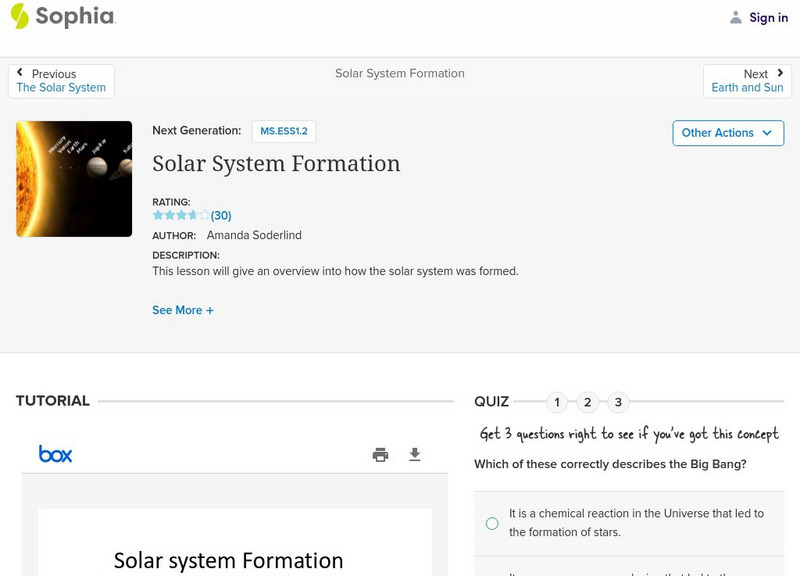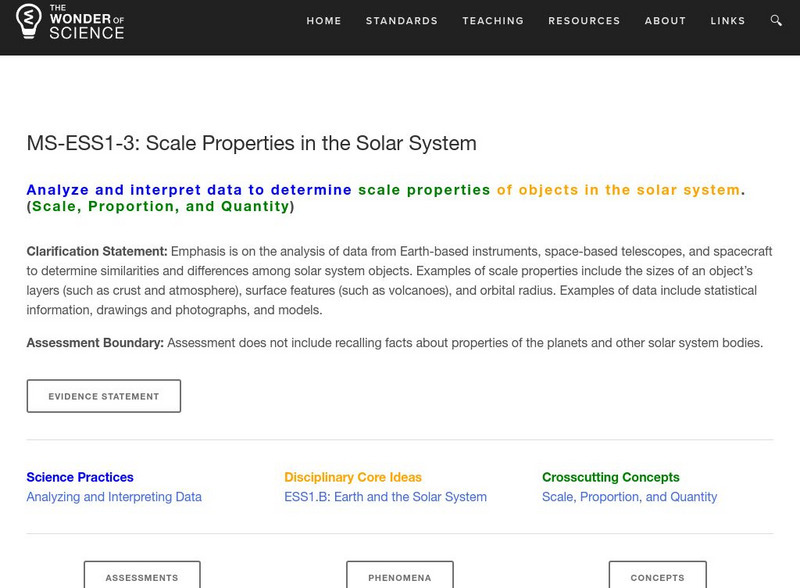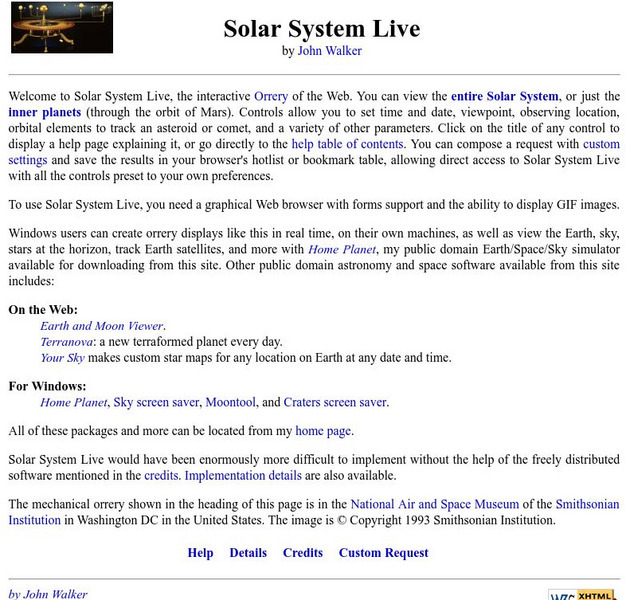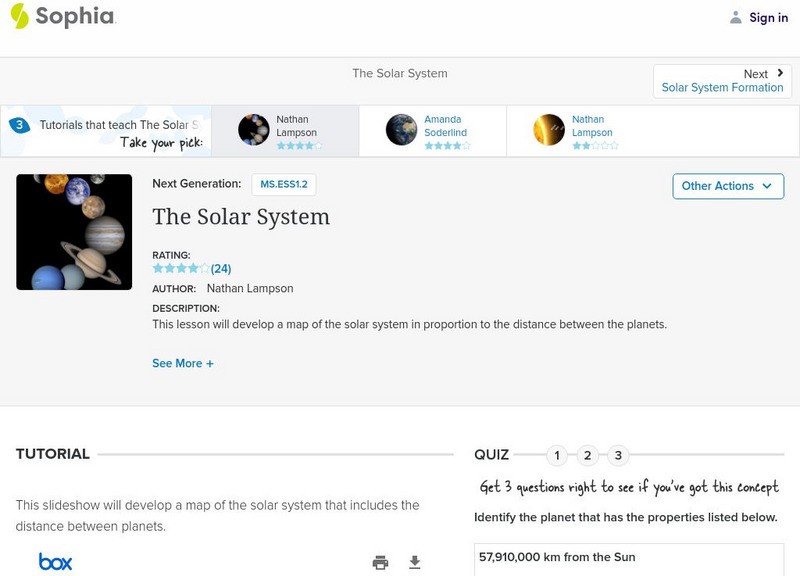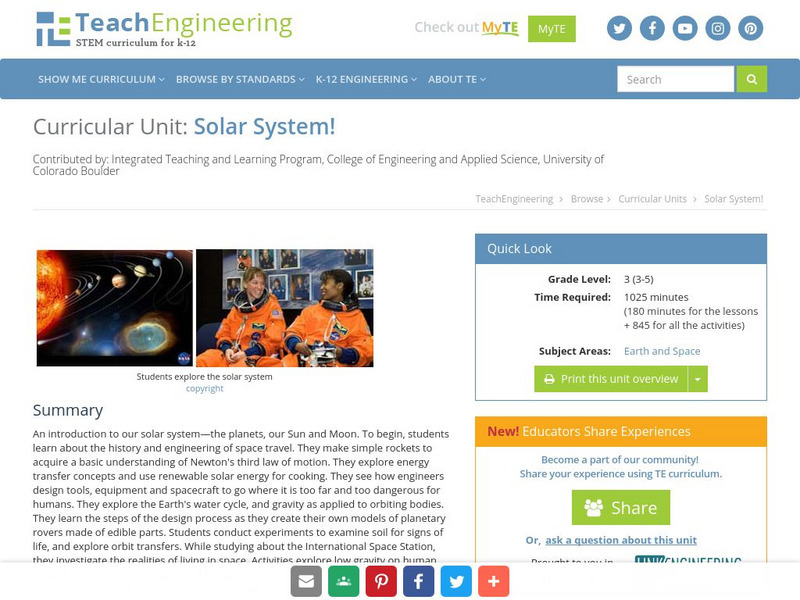Hi, what do you want to do?
Polk Brothers Foundation Center for Urban Education at DePaul University
De Paul University: Center for Urban Education: Learning About the Solar System [Pdf]
"Learning about the Solar System" is a one page, nonfiction, reading passage about scientists and learning about our solar system and how it works. It is followed by constructed-response questions which require students to provide...
Sophia Learning
Sophia: Solar System Formation
An illustrated slide show highlighting the origin and make-up of our solar system.
Science Buddies
Science Buddies: How Big Are the Planets in Our Solar System?
This activity explores the relative size of the eight planets that circle around the Sun.
Khan Academy
Khan Academy: Activity: Scale of the Universe on a String
This activity will help your students comprehend the huge scales of time and space by using familiar objects. You can explore the massive distances of our Solar System using scale models made out of string. Included is a scale model of...
The Wonder of Science
The Wonder of Science: Ms Ess1 3: Scale Properties in the Solar System
Work samples, phenomena, assessment templates, and videos that directly address standard MS-ESS1-3: scale properties in the solar system.
Fourmilab Switzerland
John Walker: Solar System Live
This planetarium program allows you to create an accurate model of the solar system with icons or pictures of each planet. You can specify a date in the past or the future, change the viewpoint to any latitude/longitude, and even view in...
Harvard University
Harvard University: The Solar System
These hands-on activities are a great way for students to gain perspective on the relative sizes and distances of each planet, the relationship between the sun and Earth, and much more.
CK-12 Foundation
Ck 12: Earth Science: Planet Orbits in the Solar System
[Free Registration/Login may be required to access all resource tools.] Looks at the size and shape of planet orbits.
National Earth Science Teachers Association
Windows to the Universe: Our Solar System
Our solar system is filled with a wide assortment of celestial bodies - the Sun itself, our eight planets, dwarf planets, and asteroids - and on Earth, life itself! The inner solar system is occasionally visited by comets that loop in...
Sophia Learning
Sophia: The Solar System: Lesson 1
This lesson will develop a map of the solar system in proportion to the distance between the planets. It is 1 of 3 in the series titled "The Solar System."
NASA
Nasa: Our Solar System Overview
This site has links to all the planets, providing an overview of the solar system. It also contains information about asteroids, meteors, comets and other features of our solar system.
BBC
Bb Ci Space: Solar System
Take a journey through the solar system with this interactive guide. Includes planetary history, "travel information," "tourist highlights," and video clips. Games and quizzes include a Solar System jigsaw that prompts the student to...
TeachEngineering
Teach Engineering: Solar System!
An introduction to our solar system: the planets, our Sun and our Moon. Students begin by learning the history and engineering of space travel. They make simple rockets to acquire a basic understanding Newton's third law of motion. They...
National Geographic
National Geographic: Extreme Weather on Other Planets
Examine the variety of weather found on all of the planets in the solar system with this classroom exercise. Students will see a video and observe differences and similarities among the planets.
American Museum of Natural History
American Museum of Natural History: Solar System O Logy Card
Here's an Ology Card about the Solar System, offering a small image, a definition, and information on how "far out" our Solar System is. Includes questions to quiz your knowledge and quick facts about the Solar System's size, rotation...
Science Education Resource Center at Carleton College
Serc: Planets Made Real: Creating Size and Distance Scale of Planets
An activity where students build a scale model of the solar system based on a marble they pick from a bowl. After choosing a marble that represents Earth, students must calculate the size of the other planets and the sun. Site includes...
NASA
Nasa: Solar System Exploration: Planets
This impressive compilation of ideas is a great source for space science. Loaded with extra links for further information on the solar system.
Science Education Resource Center at Carleton College
Serc: Build Your Own Solar System
This Java applet creates a model of a solar system with user-defined data. Users can create a solar system with up to four planets, choosing the star type at the center of the solar system, planet name, size, eccentricity of orbit and...
Space Telescope Science Institute
Hubble Site: Solar System Images
A listing of clickable images of objects in the Solar System from the Hubble telescope that includes the following: Venus, Mars, Jupiter, Jupiter's satellites, Saturn, Saturn's rings and satellites, Uranus, Uranus' rings and satellites,...
CK-12 Foundation
Ck 12: Earth Science: Formation of the Sun and Planets
[Free Registration/Login may be required to access all resource tools.] How the Sun and planets formed.
ClassFlow
Class Flow: Astronomy and the Solar System
[Free Registration/Login Required] This flipchart presents the layers of the Sun and the components of the solar system.
Science Education Resource Center at Carleton College
Serc: Creating the Solar System
This two-part lesson begins with a lecture which describes the complex process of creation from molecular cloud to planetesimals to planets to organized solar system. The lecture is followed up with a draw/write activity in which the...
NASA
Nasa: Space Place: Solar System Switch a Roo
Play this creative puzzle game where the player views a solar system object that is all mixed-up. Try and find the matching parts of the photograph, and learn about the solar system in the process.
Cosmos 4 kids
Cosmos4 kids.com: Solar System Details
This comprehensive site delves into other aspects of our solar system besides the planets and the sun. Click on the topics on the right like solar winds, the heliosphere, the heliopause, asteroids, comets, and more.





![De Paul University: Center for Urban Education: Learning About the Solar System [Pdf] Unit Plan De Paul University: Center for Urban Education: Learning About the Solar System [Pdf] Unit Plan](https://static.lp.lexp.cloud/images/attachment_defaults/resource/large/FPO-knovation.png)
